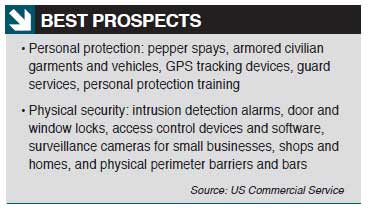The world’s 12th largest economy and the second largest Latin American market for security electronics, Mexico boasts great potential due to its ongoing internal security threats, government initiatives and business investments. No stranger to high-end products and services, the country is, in many ways, just one step behind its largest neighbor and is facing and quickly adapting to its own growing pains. A&S explores how the locals have not only survived but thrived in this highly competitive and versatile market.
The world's 12th largest economy and the second largest Latin American market for security electronics, Mexico boasts great potential due to its ongoing internal security threats, government initiatives and business investments. No stranger to high-end products and services, the country is, in many ways, just one step behind its largest neighbor and is facing and quickly adapting to its own growing pains. a&s explores how the locals have not only survived but thrived in this highly competitive and versatile market.
Before Brazil was elected as the host country of the 2014 FIFA World Cup and 2016 Summer Olympic Games, Mexico was the biggest security market in Latin America for a number of reasons: ongoing drug wars, its proximity to the U.S., close ties to the other Latin American nations, free trade, and nonstop government and business investments.
Industry consensus pegs the Mexican security equipment (and software) market at between US$160 to $220 million. Pelco's estimation of the video equipment (and software) portion is around $100 million, said Alejandro Rodríguez, Partners Sales Manager for Buildings Business, Schneider Electric. “The high-end segment accounts for roughly 40 percent.”
Axis Communications agreed with the estimated figure on video. “In terms of technology adoption, Mexico is a mature market,” said Fernando Esteban, Country Manager and Area Manager for Central America and the Caribbean. “For us, IP video has been growing at more than 40 percent per year for the past five years. For projects involving 50 cameras or more, the technology leap is incredible as end users directly go for the latest.”
For companies focusing more on the mid-to-low end, the aftereffects of the 2008/2009 financial crisis were long gone by the end of 2010. “We experienced more than 30 percent of growth last year,” said Daniel Hernández, Security Sales Manager at Syscom, one of the largest distributors in the country. “And the first quarter — traditionally the quietest one throughout the year — of this year saw a growth rate of 24 percent, with the second half of this year looking to grow exponentially because of a number of large projects.” 
Sermax, another major local distributor with a strong IT background, had a slightly higher estimate on the video market. “It should be around $120 million. The IP/analog split will change from 30/70 to 50/50 this year, at least in our own sales,” said Ruth Lozano, President.
Key market drivers include legal, psychological and economic ones. “Mexico follows in the footsteps of the U.S.,” said Jesús Fierro, Business Development Manager at Bosch Security Systems. “New rules, regulations and legislations are always surfacing, and that means constant changes in technologies and applications; so, people here are always learning new things.
Psychologically, fear drives the security business; unfortunately, serious crime is rampant in most parts of this region, including Mexico. Economically, Mexico has signed a number of bilateral trade agreements with many countries over the last decade; 95 percent of security imports are duty-free.”
PROMISING LAND
Top verticals include government (city surveillance and transportation), health care, industrial and retail. “The industrial zone in Monterrey and border areas in the north have really boomed,” Esteban said. “Corporations with scattered sites, SMBs and retail outlets are notably on the rebound as well, with fiber to the home/business becoming more mature and prevalent.”
Critical infrastructure projects such as airports, utilities, energy, prisons and city surveillance are high on Bosch's list. “Oil and gas facilities, such as mobile offshore production units and gas stations, commercial buildings, financial institutions, retail stores and gated residential units are also our target areas,” Fierro said.
With its largest Latin American operation in Mexico, Anixter focuses on system integrators and installers in the hospitality, financial and retail industries. “Unfortunately, security and drug problems have long plagued this country,” said Andrés Macías, Marketing Manager. “Products with warranties and added value go a very long way, and we also provide presales engineering, financial support and complete logistics.”
 For Genetec, some of its largest projects take place in the region. “For example, we help one of the top retailers in the country manage close to 15,000 cameras across 2,500 stores,” said Abelardo Tous-Mulkay, Sales and Business Development Manager for Latin America and Caribbean. “The retail sector is price-sensitive and loss-sensitive — it is a ‘cents' business! So, it is about more than just surveillance; video streams can help with asset management and merchandising decisions. We are also involved in a myriad of public safety, transportation (including intelligent transportation systems and ports), correctional facilities, gaming and industrial/enterprise projects.”
For Genetec, some of its largest projects take place in the region. “For example, we help one of the top retailers in the country manage close to 15,000 cameras across 2,500 stores,” said Abelardo Tous-Mulkay, Sales and Business Development Manager for Latin America and Caribbean. “The retail sector is price-sensitive and loss-sensitive — it is a ‘cents' business! So, it is about more than just surveillance; video streams can help with asset management and merchandising decisions. We are also involved in a myriad of public safety, transportation (including intelligent transportation systems and ports), correctional facilities, gaming and industrial/enterprise projects.”
Business between analog and IP is already at 50/50 for Magocad, one of the top five distributors in the country. “At the high-end, we help our clients make projects in the banking, retail and industrial sectors,” said Guillermo Hernández, Key Account Manager. “At the low end, residential units and apartments account for about 30 percent of our business.”
Following closely behind Pelco in market share, Samsung Techwin is doing particularly well in government, health care, banking, oil/gas and retail. “Compared to the U.S., which is brownfield, Latin America is greenfield as 60 to 75 percent of new projects go for IP directly,” said Pedro Duarte, VP of Sales and Business Development for Latin America. “This translates to a regional surveillance market of $300 million. We are expecting to grow at least 16 percent per year until 2016, and having our own technology to be innovative really helps. While living with the market and providing what it requires, we find end users much more educated and comfortable with new features these days.”
Despite unpredictability and instability in world and Mexican economies, Inalarm — another top-rank distributor — has made considerable strides in all the verticals mentioned above. “Innovation, brand name, installed base and warranty can really set players apart,” said Ricardo Guzmán, Sales Director.
Aside from free trade with the U.S., which makes imports effortless, the proximity also simplifies support and troubleshooting. “Latin Americans hate to read, so having product literature and software interfaces in Spanish is not enough,” said Manuel Hernández, Sales Director for South America and the Caribbean, Lanier Representation Group (LRG). “Face-to-face meetings and handshakes are still very much required, which also help increase the comfort level of your clients in the products and services you provide.”